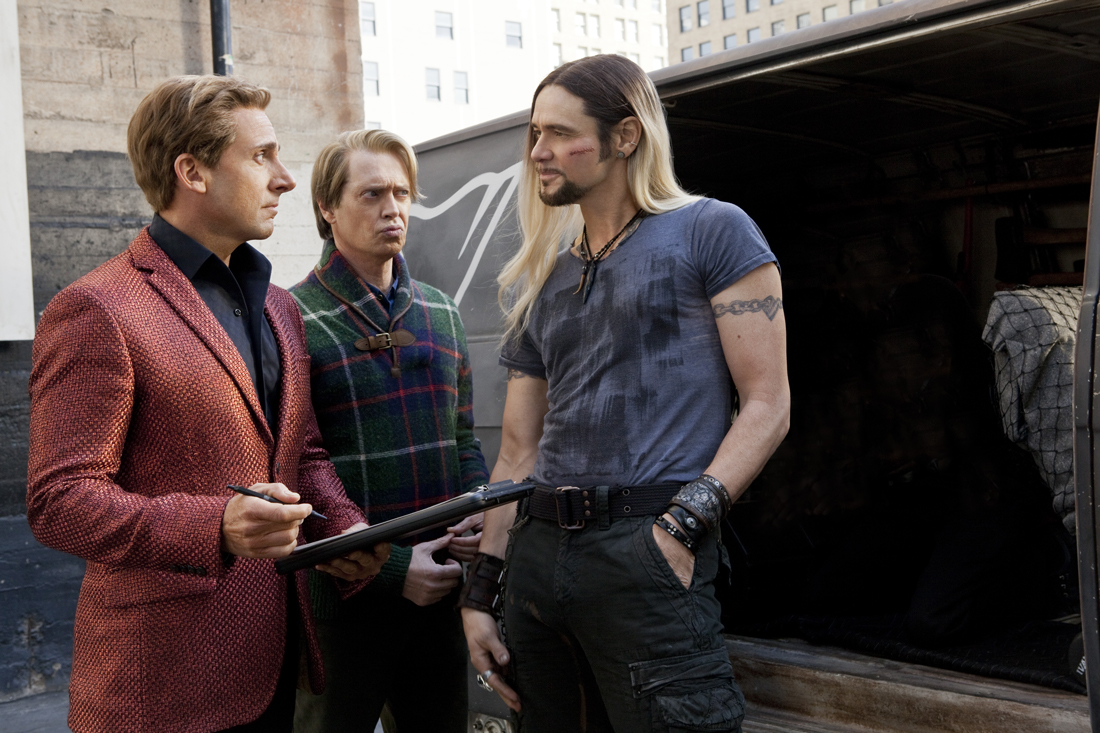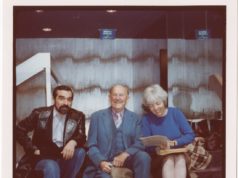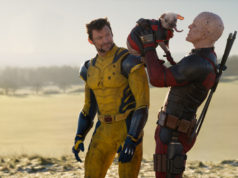One of the earliest filmmakers, Georges Meliès, started out as a magician, so it’s really no surprise that filmmakers have long felt an affinity with magicians. They both practice the art of diverting our attention for the purpose of dazzling us and defying the laws of physics. Both movies under discussion this week look to wow us with their sleight of hand, but magic is a quality they both seem a bit short on.
More prosaic than incredible, The Incredible Burt Wonderstone stars Steve Carell as the title character, a stage magician who’s at the top of his trade, comfortably ensconced at a Las Vegas hotel casino with his onstage partner and lifelong best friend Anton Marvelton (Steve Buscemi). After 10 years, though, the act has gone stale, Burt has turned into a complacent egomaniac, and their following has been leached away by Steve Gray (Jim Carrey), a loathsome hack whose Jackass-style stunts and shock tactics have corralled a younger audience. The partnership disintegrates under the pressure to keep up, and Burt unravels into a boozy, unemployable mess. He’s reduced to playing nursing homes and Big Lots stores before he rediscovers his love for the craft of prestidigitation.
You’ll be glad to know that the movie is out to do more than just make fun of guys who wear eyeliner, sequined costumes, and ridiculous hairstyles for professional purposes. The movie grasps an essential truth about performing artists in the middle section, when Burt finds guidance from the retired magician (Alan Arkin) who first inspired him. “That awe you’re feeling right now? It’s why you do magic!” says the old man as he conjures a pigeon out of a salt shaker. “The audience wants to believe the trick, but how are they supposed to believe it if you don’t believe it?” Soon afterward, Burt and his mentor are making golf balls appear out of thin air for a bunch of other retirees, and the movie captures the simple pleasure that comes from entertaining an audience.
There are funny gags sprinkled throughout this thing, and they come from more than just the movie’s stars. These include Gillian Jacobs (from TV’s Community) as a groupie who spends a weird night with Burt and Jay Mohr as a pathetic magician who sadly envies his betters from a distance. As Burt’s put-upon stage assistant, Olivia Wilde displays an unsuspected flair for physical comedy, especially in the early scenes when her character is hastily promoted from a backstage manager position and squeezed into the assistant’s tiny costume. Carrey seems energized playing the villain — his customary mugging goes down easier in an attention-hogging character who doesn’t need to be likable.
For all this, the movie never builds up any comic momentum. Directing his first movie, TV veteran Don Scardino can’t bring off any of the set pieces, which include Burt and Anton being suspended above the street in a Plexiglas box and Steve upstaging Burt at a kids’ birthday party. Buscemi serves gamely as a straight man, but the chemistry between him and Carell never clicks, whether the characters are on or offstage. And while I’d rather see the daffy Carell than the buttoned-up version from Hope Springs or Seeking a Friend for the End of the World, he’s too nice for the part here. The star’s innate decency makes him suited to play well-meaning bumblers, but Burt is a different animal, a lecherous guy who carelessly stomps on the people around him. A different actor (Carrey, for one) could have brought the hint of malice that both the role and the film could have used.
The movie finally hits a sweet spot during the closing credits, when it’s revealed how Burt and Anton pull off a trick called The Disappearing Audience. (They make the crowd reappear in another place. They don’t drive the audience from the theater.) The bit is pure slapstick but no less effective for that. Still, the fact that it takes so long for the movie to find a groove says volumes. If The Incredible Burt Wonderstone were a magic act, you’d say it needed polishing before it was ready for the big stage.
Oz the Great and Powerful is also about magic, and it’s the latest in the body of works inspired by L. Frank Baum’s novels and, of course, Victor Fleming’s 1939 musical fantasy. Though the credits list the script as being based on Baum’s The Wonderful Wizard of Oz, the plot is wholly original, detailing how a young man from Kansas gets to be the revered enchanter of that fantasy land. I suppose you could use the word “prequel,” but I’m not going to. This family-friendly epic reaped a big haul at the box office last week, but it’s a mess, good-looking though it is.
A black-and-white prologue set in 1880 follows Kansas stage magician Oscar Diggs (James Franco) as he travels with a circus and dreams of a brilliant career surpassing the accomplishments of Thomas Edison and Harry Houdini. After hitting on a co-worker’s girlfriend, he escapes the man’s wrath by sailing off in a hot air balloon, only to be sucked into a tornado. When he awakes, he’s in the rendered-in-color land of Oz, where magically empowered sisters named Evanora and Theodora (Rachel Weisz and Mila Kunis) mistake him for a wizard and offer him a kingdom in exchange for avenging their murdered father.
Director Sam Raimi and cinematographer Peter Deming first worked together on Evil Dead II, and they paint the movie in showstopping colors: the jeweled greens of the Emerald City, the deep red in Theodora’s 1960s-tinged outfit, the brighter red in the poppy field outside the city. The CGI-rendered China Girl (voiced by Joey King), a two-foot tall porcelain figurine imbued with life, is an uncanny creation. The climactic sequence also provides a great visual, when Oscar uses some early moving-picture technology to convince the people of Oz that he is indeed a wizard.
Unfortunately, this thing is tone deaf. The movie lurches from slapstick comedy to magical lyricism to action film, and it misses badly whether it’s aiming for pathos, as with the China Girl, or for cuteness, as with a talking monkey (voiced by Zach Braff) who becomes Oscar’s servant. The performances are all over the place, too. Kunis misses the temperamental undercurrents that inflame Theodora, and Franco looks uneasy as a con man who’s been pressed into the role of a hero. The only time the movie catches fire is when the impeccable Michelle Williams is on screen as Glinda the Good. Somehow, she manages to find the right mix of ethereal, funny, and saddened by the infighting that has gripped the land. Williams has given a number of terrific recent performances in decent-to-great films, but doing so amid such chaos is somehow even more impressive. If only the rest of the movie had been so perfectly pitched.
[box_info]
The Incredible Burt Wonderstone
Starring Steve Carell, Steve Buscemi, and Jim Carrey. Directed by Don Scardino. Written by Jonathan M. Goldstein and John Francis Daley. Rated PG-13.
Oz the Great and Powerful
Starring James Franco, Mila Kunis, Rachel Weisz, and Michelle Williams. Directed by Sam Raimi. Written by Mitchell Kapner and David Lindsay-Abaire, based on L. Frank Baum’s novels. Rated PG.
[/box_info]












